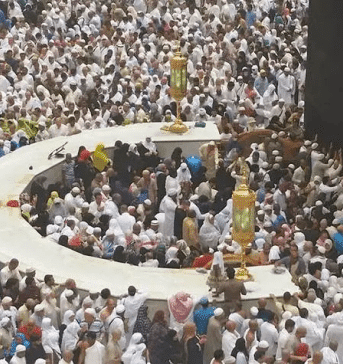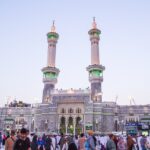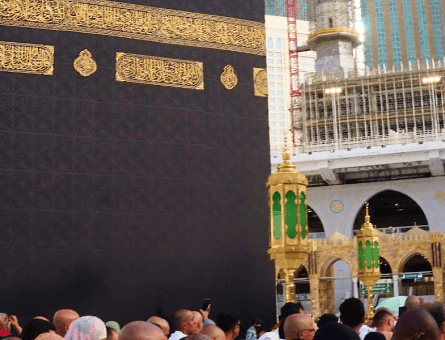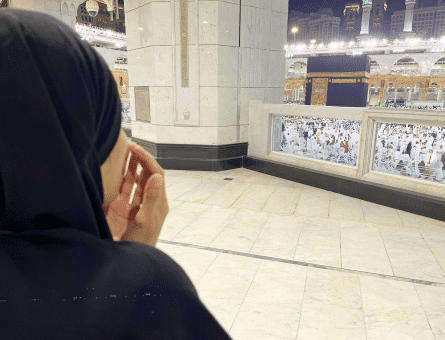Hijr Ismail – What is the Hateem?
Hijr Ismail, also known as Hateem or Stone of Ismail, is a three-meter wide area adjacent to the north-western wall of the Sacred Kaaba.
The area of Hijr Ismail is enclosed by a semi-circular (crescent-shaped wall) made out of marble. Although the wall of Hijr Ismail is not directly connected to the wall of the Kaaba, it is considered a part of the Sacred Kaaba. Throughout the history of Islam, several sacred events have taken place on the surface of Hijr Ismail.
Read on to learn more about the significance of Hijr Ismail in Islam.
What Is Hijr Ismail?
Hijr Ismail can be described as a semi-circular wall adjacent to the northwest wall of the Holy Ka’bah. The white marble wall is 4 feet 4 inches (1.32 metres) tall and 2 feet 11 inches (0.90 metres) wide. Although Hijr Ismail is not directly connected to the Sacred Kaaba, it is believed that the three-metre-wide area is indeed part of the Sacred Kaaba.
Therefore, even today, during Tawaf, Muslims are not allowed to enter or walk inside the space between the wall of the Ka’bah and Hateem. It was given the name Hijr Ismail – Stone of Ismail – as it was where Prophet Ibrahim (AS) built a shelter for his son Prophet Ismail (AS) and wife Hajrah (AS).
“When asked about praying inside the Kaaba, Shaykh ibn Baaz (may Allah have mercy on him) said: “Praying inside Hijr Ismail (Hateem) is mustahabb, because it is part of the Kaaba, and it is narrated in a sahih hadith from the Prophet Muhammad (PBUH) that he entered the Kaaba during the year of the conquest (of Makkah) and prayed two Rakats inside it.””
The History of Hijr Ismail
Hijr Ismail holds significant value in Islam. It was initially constructed by Prophet Ibrahim (AS) and later by the Quraysh during the reconstruction of the Sacred Kaaba. According to Islamic history, it is believed that when Prophet Ibrahim (AS), his son Prophet Ismail (AS) and his wife Hajra (AS) arrived in Makkah, Saudi Arabia they had no shelter over their heads.
That’s when Allah Almighty ordered Angel Jibrael (AS) to guide the family to the exact place where the current Hijr Ismail is located. On arriving at the barren land, Prophet Ibrahim (AS) used the branches of nearby trees to create a shelter for his wife and son. Therefore, it was given the name “Bayt Ismail” meaning “House of Ismail.”
Several Islamic sources claim that after Hajra (AS) passed away, she was buried in the area of Hateem. Later onwards, Prophet Ismail (AS) constructed a fence around his mother’s grave to prevent people from stepping on it. However, it is also believed that the grave of Prophet Ismail (AS) is also situated in Hijr Ismail.
The story behind the construction of Hijr Ismail doesn’t end here; it was rebuilt again during the era of the Quraysh. This was when Prophet Muhammad (PBUH) was 35 years old, and the Sacred Kaaba had faced severe damages due to a flood.
While the Quraysh were finalizing the construction of the Kaaba, due to a financial crunch, they were not able to connect the Hijr Ismail to the wall of the Kaaba. Hence, the people of the Quraysh decided to build a small wall at the northwest side of the Sacred Kaaba around the foundation laid by Prophet Ibrahim (AS).
The Prophet Muhammad (PBUH) was asked by Aisha (RA) about the reason behind Hijr Ismail not being connected to the walls of the Kaaba, to which he (SAW) replied, “Because your people (the Quraysh) did not have sufficient funds.” [Bukhari]
Since then, the wall has been recognized as Hijr Ismail.
Photo of the Hijr Ismail

Importance of Hateem in Kaaba
It is believed that the rewards that a Muslim receives after praying inside Hateem are equivalent to the blessings the one receives after praying inside the Sacred Kaaba. The significance of praying inside the Hijr Ismail is supported by the following narration of Aisha (AS):
“When I expressed the wish to perform salah within the Kaaba, the Prophet (ﷺ) took me by the hand and led me into the Hijr (Hateem) where he (SAW) said, ‘Perform salah here if you wish to enter the Kaaba because this is part of the Baitullah.” (Bukhari)
Moreover, it must be noted that only the three-meter-wide area that is adjacent to the wall of the Holy Kaaba on the side of Hijr Ismail is considered an actual part of the Kaaba. However, in all cases, Muslims must perform Tawaf outside the complete area of Hijr Ismail.
While performing Hajj or Umrah, thousands of Pilgrims offer two Rakat of Nafl within the sacred area.
One of the several narrations of the Prophet Muhammad (PBUH) that prove that Hateem is indeed the part of the Sacred Kaaba is as follows:
“O, Aisha! Had your people not very recently been in the Period of Ignorance, I would have had the Kaaba demolished and included the left-out portion within its walls. I would have also brought the inside of the Kaaba to ground level and added two doors, with one on the eastern wall and the other on the western wall. In this manner, it would be according to the building and foundation of Prophet Ibrahim (AS).” (Bukhari)
Facts about the Hijr Ismail
Listed below are some surprising facts about Hijr Ismail that highlight its importance in Islam:
- Fact 1: The Dream of Abdul Muttalib
Prophet Muhammad (PBUH)’s grandfather Abdul Muttalib used to love sitting in the area of Hateem. One night while he was sleeping, he dreamt of a shadowy figure that directed him to the Zamzam well, hidden underground since the Jurhum tribe.
- Fact 2: The Secret Way to Pray Inside the Sacred Kaaba
With a wish to pray inside the Sacred Kaaba, Aisha (RA) asked Prophet Muhammad (PBUH), “O Messenger of Allah! Can I not enter the House?” On which Prophet Muhammad (PBUH) replied, “Enter the Hijr Ismail or Hateem as it is part of the House.” (Sunan an-Nasa’i 2911)
- Fact 3: Prophet Muhammad (PBUH) Stood on Hijr Ismail
According to a narration of Jabir Bin ‘Abdullah (RA), it was Hijr Ismail where Prophet Muhammad (PBUH) stood while he narrated the event of Miraj to the people of Quraysh. Prophet Muhammad (PBUH) said, “When the people of Quraysh did not believe me (i.e. the story of my Night Journey), I stood upon the Hijr Ismail or Hateem and Allah displayed Jerusalem in front of me, and I began describing it to them while I was looking at it.” (Sahih al-Bukhari 3886)
- Fact 4: Meezab-e-Rahmah
Meezab-e-Rahmah is a channel of water that starts from the roof of the Sacred Kaaba and ends at the Hateem area. It is also known as the water outlet of mercy.
Summary – Hijr Ismail
Hijr Ismail is a semi-circular shaped area parallel to the walls of the Sacred Kaaba. It is located on the north-western side of the Kaaba. The boundaries of Hateem are made of marble. The blessings of praying inside Hateem are equivalent to that of praying inside the Holy Kaaba.
Explore The New Pilgrim App
The Ultimate App
for Hajj and Umrah!











